
A mushroom or toadstool is the fleshy, spore-bearing fruiting body of a fungus, typically produced above ground, on soil, or on its food source.
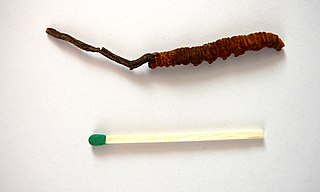
Ophiocordyceps sinensis is known in English colloquially as caterpillar fungus, or by its more prominent names yartsa gunbu, or dōng chóng xià cǎo or Yarsa-gumba or Yarcha-gumba, or Keeda Jadi, or ရှီးပတီး. It is an entomopathogenic fungus in the family Ophiocordycipitaceae. It is mainly found in the meadows above 3,500 meters on Tibetan Plateau in Southwest China and Himalayan regions of Bhutan and Nepal. It parasitizes larvae of ghost moths and produces a fruiting body which used to be valued as a herbal remedy and in traditional Chinese medicine. Caterpillar fungus contains the compound Cordycepin, an adenosine derivative. However, the fruiting bodies harvested in nature usually contain high amounts of arsenic and other heavy metals so they are potentially toxic and sales have been strictly regulated by the CFDA since 2016.
In mycology, the terms teleomorph, anamorph, and holomorph apply to portions of the life cycles of fungi in the phyla Ascomycota and Basidiomycota:

Sordaria fimicola is a species of microscopic fungus. It is commonly found in the feces of herbivores. Sordaria fimicola is often used in introductory biology and mycology labs because it is easy to grow on nutrient agar in dish cultures. The genus Sordaria, closely related to Neurospora and Podospora, is a member of the large class Sordariomycetes, or flask-fungi. The natural habitat of the three species of Sordaria that have been the principal subjects in genetic studies is dung of herbivorous animals. The species S. fimicola is common and worldwide in distribution. The species of Sordaria are similar morphologically, producing black perithecia containing asci with eight dark ascospores in a linear arrangement. These species share a number of characteristics that are advantageous for genetic studies. They all have a short life cycle, usually 7–12 days, and are easily grown in culture. Most species are self-fertile and each strain is isogenic. All kinds of mutants are easily induced and readily obtainable with particular ascospore color mutants. These visual mutants aid in tetrad analysis, especially in analysis of intragenic recombination.

The blusher is the common name for several closely related species of the genus Amanita. A. rubescens or the blushing amanita, is found in Europe and eastern North America, and A. novinupta, also known as the new bride blushing amanita, is found in western North America. Both their scientific and common names are derived from the propensity of their flesh to turn pink on bruising, or cutting.

Erysiphales are an order of ascomycete fungi. The order contains one family, Erysiphaceae. Many of them cause plant diseases called powdery mildew.

Trichoderma viride is a fungus and a biofungicide.

Hypomyces is a genus of parasitic ascomycete fungi found in Europe, North America, Australia, and parts of China. The genus contains 53 species. Better known species include the lobster mushroom and the bolete eater.
This is a glossary of some of the terms used in phytopathology.

Botryosphaeria dothidea is a plant pathogen that causes the formation of cankers on a wide variety of tree and shrub species. It has been reported on several hundred plant hosts and on all continents except Antarctica. B. dothidea was redefined in 2004, and some reports of its host range from prior to that time likely include species that have since been placed in another genus. Even so, B. dothidea has since been identified on a number of woody plants—including grape, mango, olive, eucalyptus, maple, and oak, among others—and is still expected to have a broad geographical distribution. While it is best known as a pathogen, the species has also been identified as an endophyte, existing in association with plant tissues on which disease symptoms were not observed. It can colonize some fruits, in addition to woody tissues.

Glomerella cingulata is a fungal plant pathogen, being the name of the sexual stage (teleomorph) while the more commonly referred to asexual stage (anamorph) is called Colletotrichum gloeosporioides. For most of this article the pathogen will be referred to as C. gloeosporioides. This pathogen is a significant problem worldwide, causing anthracnose and fruit rotting diseases on hundreds of economically important hosts. Laid out here is an overview of some of the most important aspects of this pathogen.

Chorioactis is a genus of fungi that contains the single species Chorioactis geaster. The mushroom is commonly known as the devil's cigar or the Texas star in the United States, while in Japan it is called kirinomitake (キリノミタケ). This extremely rare mushroom is notable for its unusual appearance and disjunct distribution; it is found only in select locales in Texas and Japan. The fruit body, which grows on the stumps or dead roots of cedar elms or dead oaks, somewhat resembles a dark brown or black cigar before it splits open radially into a starlike arrangement of four to seven leathery rays. The interior surface of the fruit body bears the spore-bearing tissue known as the hymenium, and is colored white to brown, depending on its age. The fruit body opening can be accompanied by a distinct hissing sound and the release of a smoky cloud of spores.
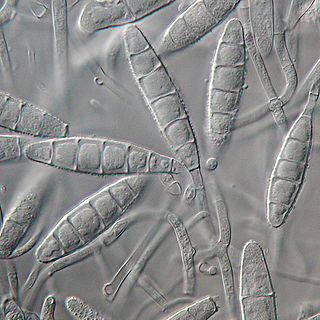
Microsporum gypseum is a soil-associated dermatophyte that occasionally is known to colonise and infect the upper dead layers of the skin of mammals. The name refers to an asexual "form-taxon" that has been associated with four related biological species of fungi: the pathogenic taxa Arthroderma incurvatum, A. gypsea, A. fulva and the non-pathogenic saprotroph A. corniculata. More recent studies have restricted M. gypseum to two teleomorphic species A. gypseum and A. incurvatum. The conidial states of A. fulva and A. corniculata have been assigned to M. fulvum and M. boullardii. Because the anamorphic states of these fungi are so similar, they can be identified reliably only by mating. Two mating strains have been discovered, "+" and "–". The classification of this species has been based on the characteristically rough-walled, blunt, club-shaped, multicelled macroconidia. Synonyms include Achorion gypseum, Microsporum flavescens, M. scorteum, and M. xanthodes. There has been past nomenclatural confusion in the usage of the generic names Microsporum and Microsporon.

Ceratobasidium is a genus of fungi in the order Cantharellales. Basidiocarps are effused and the genus is sometimes grouped among the corticioid fungi, though species also retain features of the heterobasidiomycetes. Rhizoctonia-like anamorphs of Ceratobasidium species are placed in the genus Ceratorhiza. Species are saprotrophic, but several are also facultative plant pathogens, causing a number of commercially important crop diseases. Some are also endomycorrhizal associates of orchids.

The fungi imperfecti or imperfect fungi, are fungi which do not fit into the commonly established taxonomic classifications of fungi that are based on biological species concepts or morphological characteristics of sexual structures because their sexual form of reproduction has never been observed. They are known as Imperfect Fungi because only their asexual and vegetative phases are known. They have asexual form of reproduction, meaning that these fungi produce their spores asexually, in the process called sporogenesis.
The Heterogastridiales are an order of fungi in the Microbotryomycetes class of the Basidiomycota. The order contains a single family, the Heterogastridiaceae, which in turn contains five genera. Both the family and the order were circumscribed in 1990.
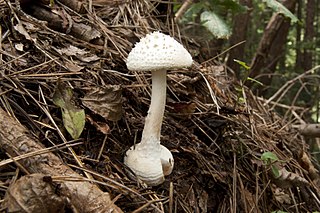
Amanita sphaerobulbosa, commonly known as the Asian abrupt-bulbed Lepidella, is a species of agaric fungus in the family Amanitaceae. First described by mycologist Tsuguo Hongo in 1969, it is found in Southern Asia. The species was formerly consider synonymous with the North American lookalike Amanita abrupta, but that species has narrower spores, a persistent partial veil, and lacks the refractive contents found in the hyphae and inflated cells of A. sphaerobulbosa.
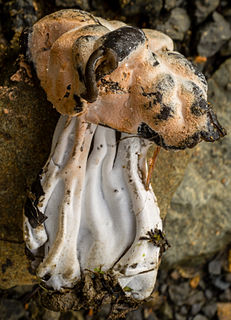
Hypomyces cervinigenus is a parasitic ascomycete fungus that grows on elfin saddle (Helvella) mushrooms in Europe and North America. It was described as new to science in 1971 by Clark Rogerson and Horace Simms. The type collection was made in Pierce County, Washington, where the fungus was found growing on the stipe and cap of what they identified as a fruit body of Helvella lacunosa; later molecular work demonstrated that the European H. lacunosa is not found in North America, and that the North American versions are in fact two similar species, H. vespertina and H. dryophila. H. cervinigenus has perithecia that are white to pale buff with a waxy texture. The ascospores are two-celled, smooth-walled, and measure less than 25 µm long. The anamorph form of the fungus is known as Mycogone cervina.
Scytalidium ganodermophthorum is an anthroconidial ascomycete fungus in the Scytalidium genus. It is also known by its teleomorph name Xylogone ganodermophthora. It is the cause of yellow rot in lingzhi mushrooms and it is used in spalting as a pigmenting fungi.
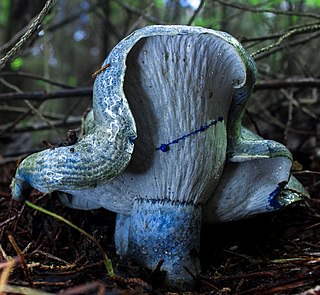
Hypomyces lateritius is a parasitic ascomycete fungus that grows on certain species of Lactarius mushrooms, improving their flavor and densifying the flesh. Hosts include L. camphoratus, L. chelidonium, L. controversus,L. deliciosus, Lactarius indigo, L. rufus, L. salmonicolor, L. sanguifluus, L. semisanguifluus, L. tabidus, L. trivialis, and L. vinosus.
















